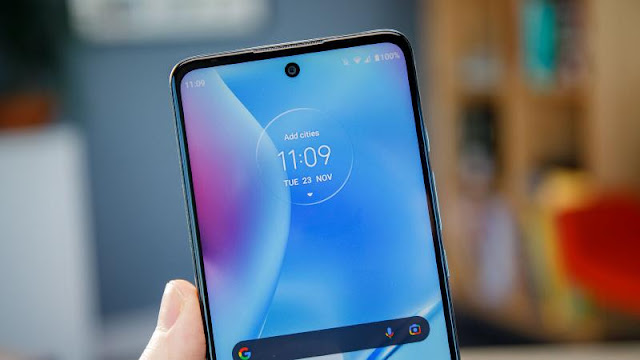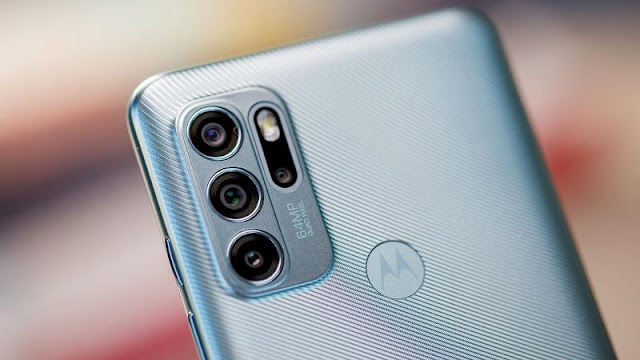The G60s combines 50W fast charging with great battery life and a 120Hz display, but similarly priced rivals provide a more well-rounded experience.
Should I Buy The Motorola Moto G60s?
Pros
- 50W fast charging
- Great battery life
- Impressive 120Hz display
Cons
- Hit-and-miss performance
- Poor cameras
- Cheap build
Our Verdict
Price When Reviewed
- $289.50
Since its acquisition by Lenovo in 2014, the Motorola brand has been releasing new phones at an alarming rate. In 2021 alone, we’ve seen a total of 35 Moto handsets announced, and there could be even more before the year is out.
That’s despite Motorola focusing almost exclusively on more affordable devices. It's easy for individual releases to get lost in the sea of similarly-priced Moto phones – that's before you even consider other companies.
One device seeking to avoid this fate is the Moto G60s. At £219.99/€249.99, it’s towards the more expensive end of Motorola’s 2021 lineup but remains in contention for our budget phone chart.
The headlining feature is 50W fast wired charging, something you don’t often get at this price point, but is there enough else here to make it worth your money? Here’s my full review.
Design & Build
- Attractive but cheap-feeling plastic build
- Edge-to-edge display
- 3.5mm headphone jack
As you might expect, the design of the Moto G60s is nothing we haven’t seen before. The glass display combines with a plastic back and frame, both to cut costs and keep the device lighter. At 212g, it’s relatively hefty, but I still found it comfortable enough to use on a daily basis.
The textured back helps a lot with this, adding plenty of grip and making it easy to use case-free. This design choice gives away the fact it’s a budget handset, but I’m happy practicality was prioritised over aesthetics. I found the Iced Mint finish I tested to be a bit underwhelming, but it’s also available in a more dynamic-looking Ink Blue.
The Motorola logo doubles as a rear-mounted fingerprint scanner in its classic position about a quarter of the way down the centre of the device. Many phones have shifted to in-display sensors these days, but the physical one here is extremely fast and reliable.
I certainly didn’t feel like I was missing out here, although that might be the case if you regularly use your phone while it’s resting on the table.
Flipping the phone over reveals the 6.8in LCD display, housed within some slim bezels. These are punctured by a teardrop-style notch – this houses a 16Mp selfie camera which can also be used for face unlock. Still, I really can’t complain about an 85.1% screen-to-body ratio.
However, you do still get a 3.5mm headphone jack on the top of the phone. Many people still prefer wired audio, so it’s nice to have the option here.
It'll probably be an upgrade on the sound you get from the single downward-firing speaker, despite being supplemented by the earpiece. Voices are clear and music impressively punchy, but it quickly becomes muddy and distorted at high volumes.
Screen
- 6.8in Full HD LCD display
- 120Hz variable refresh rate
- One of the phone's key strengths
Let’s talk about the main event. The display on the Moto G60s is a 6.8in LCD panel with a resolution of 1080x2460. It offers vibrant colours and plenty of detail – I certainly didn’t notice the difference between this and a 1440p panel.
OLED is another thing that would have been nice to have, but it’s absence here doesn’t affect the experience too much and is understandable at this price.
By default, this is set to automatically adjust depending on what you’re doing in order to save battery life. But you can change this to a fixed 60- or 120Hz if you’d prefer.
There's more good news when it comes to brightness. Using the SpyderX Pro, I recorded a maximum of 513 nits, making it easy to use in most outdoor environments. Direct sunlight will still be a struggle, but that’s true for the vast majority of phones.
Specs & Performance
- Helio G95 and 4GB RAM
- Underwhelming performance
- 128GB storage supports microSD expansion
The Moto G60s is powered by MediaTek’s 12nm Helio G95 chipset. It’s a popular choice for budget phones, considered roughly comparable to Qualcomm’s Snapdragon 720G. Neither supports 5G networks, but that’s not yet a dealbreaker at this price point.
It has a Mali-G76 GPU and works alongside 4GB of RAM on the model I tested. Performance isn’t bad per se, but there are enough stutters and hesitations to make everyday use frustrating. Several pre-installed Google apps also seem prone to freeze or crash.
There’s no guarantee that more RAM will solve these issues, but it should help. Basic everyday performance is still fine across web browsing, social media and watching YouTube videos, especially at 120Hz. It just doesn’t feel like something you can rely on.
Interestingly, MediaTek specifically advertises the Helio G95 as being suitable for mobile gaming. That might apply for casual games but doesn’t quite extend to demanding titles such as Call of Duty: Mobile or Asphalt 9.
Performance here is better than the specs suggest, but the G60s still has a tendency to stutter or not respond for a couple of seconds. If you’re serious about mobile gaming, I’d recommend stepping up to something more powerful.
However, the benchmarks below put it in line with many handsets around this price point:
In terms of internal storage, you’re limited to 128GB. That feels a bit on the low side, but it can easily be expanded via the microSD card slot.
Cameras
- Quadruple rear cameras
- Consistently struggles with exposure and low light
- Decent selfie camera
Cameras are always a big talking point on modern smartphones, even if they’re lower down the priority list at this price point. That rear module I mentioned earlier houses four lenses, with a 64Mp main joined by 8Mp ultrawide, 5Mp macro and 2Mp depth.
It tends to saturate what you see in real life, but that does lead to images that are more pleasing to the eye.
As is usually the case, the macro and depth sensors add very little to the photography experience. Close-up shots are lacking in detail, while portrait-style photos have a really hard time with edge detection. If you’re considering this phone, keep in mind that there are only two rear lenses you’ll be using on a regular basis.
You also get a software-based night mode (known here as ‘Night Vision’), but aside from brightening images, it doesn’t make a huge difference to low-light scenes.
On the front, a 16Mp camera produces decent selfies. It suffers from some of the same exposure issues as the rear lenses, but the subject is usually in focus and there's plenty of detail in the foreground.
Check out some of my samples in the gallery below:
Battery Life & Charging
- 5,000mAh battery
- 50W fast wired charging
- Both deliver impressive results
Battery life is a key strength for the Moto G60s. The phone has a 5000mAh capacity, although that’s needed to power the large, high refresh rate display. Still, you can comfortably get a full day’s moderate usage from a single charge – this can even be extended to two days in some cases.
That’s reflected in PCMark’s battery benchmark, designed to be reflective of real-world usage. With brightness set to 200 nits, I recorded 11 hours and 35 minutes. That’s an above-average score, even if it won’t be winning any awards.
However, an area where the Moto G60s really excels is charging, with a 50W adapter included in the box. From empty, I got to 43% in 15 minutes and 73% in half an hour. For most people, that means a full charge in the time it takes to get ready in the morning – there's really no need to charge the phone overnight.
The cable in the box is USB-C to USB-C, although there’s also the option to connect a USB-A port on the same power brick. While you don't get wireless charging, the wired charging experience more than makes up for it.
Software
- Android 11 out of the box
- No word on upgrade to Android 12
- Clean, slick user experience
The Moto G60s runs Android 11 out of the box. There’s no word on when it might get the update to Android 12, despite Google’s latest OS having been released a couple of months ago.
Motorola phones usually get two years of OS updates, so we can expect it to get Android 13 but nothing past that. That’s also when security updates usually end. I really wish Motorola would follow other phone companies in committing to longer software support.
There are a handful of additional apps which can’t be uninstalled (bloatware), but these don’t get in the way of the user experience. The ‘Moto’ app, which allows you to control a range of gesture shortcuts, is a genuinely useful addition.
Aside from some tweaks to stock apps and new widgets, it’s hard to tell the Moto software experience apart from so-called ‘stock’ Android. For many people, this is a big advantage over many Chinese phones.
Price & Availability
Globally, Motorola sells models of the Moto G60s 4GB and 6GB of RAM. However, only the former is available in the UK, at a price of £219.99. It's currently out of stock if you go direct, but still available via Amazon. It's not technically being sold in North America, but you can still buy it for $284 from Amazon US.
That makes it more expensive than most handsets in the Moto G range, but still comfortably within budget phone territory.
However, competition is fierce at this price point. The Poco X3 Pro, Redmi Note 10 Pro and Redmi Note 9T are all priced similarly. If you’d rather avoid Xiaomi handsets, the Realme 8 is another great option.
As you can see, there are plenty of excellent alternatives that deliver better value for money. You probably won’t feel shortchanged buying the Moto G60s, but not like you’ve got a bargain either.
Verdict
The Moto G60s hardly reinvents the wheel with regards to Motorola phones, but it does impress in several key areas.
Battery life from the 5000mAh cell is solid, while the 50W adapter in the box makes charging a breeze. The software experience is excellent (despite being based on Android 11) I really enjoyed using the 120Hz display.
However, there are other key pillars of a great phone where the Moto G60s doesn’t quite hit the mark. Performance isn’t great for anything more than basic usage and the cameras are unreliable. With no 5G and a rather cheap build, you’ll have to be content with plenty of compromises.
That’s to be expected at this price point to some extent, but several other budget phones deliver more of what the average person is looking for. As such, it’s difficult to recommend the G60s unless you’re only considering Motorola handsets.
Specs
- 6.8in 60Hz Full HD+ (1080x2460) LCD display
- Rear-mounted fingerprint sensor
- 64Mp main camera, f/1.7, PDAF
- 8Mp ultrawide camera, f/2.2, 119° FoV
- 5Mp macro camera, f/2.4
- 2Mp depth sensor, f/2,4
- 16Mp hole-punch front camera, f/2.2
- USB-C
- Dual SIM
- 5000mAh battery
- Wired charging up to 50W
- MediaTek Helio G95 4G chipset
- 4GB RAM
- 128GB storage
- Android 11
- WiFi 802.11
- Bluetooth 5.0
- 212g
- 169.7 x 75.9 x 9.6mm























0 comments:
Post a Comment